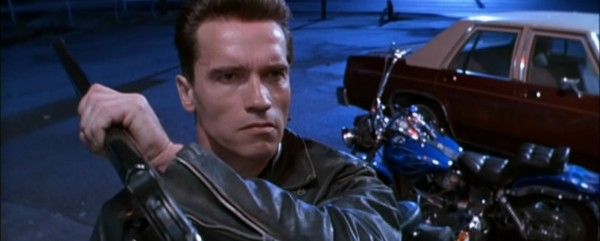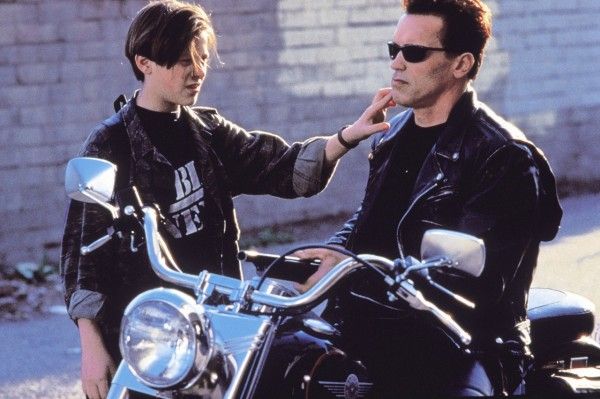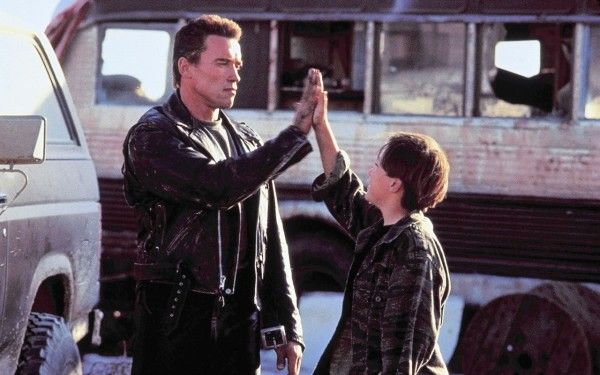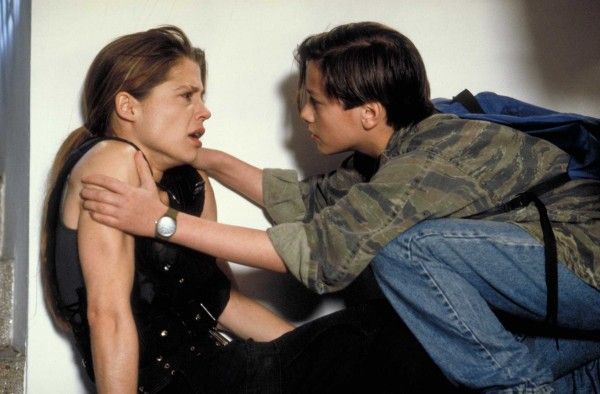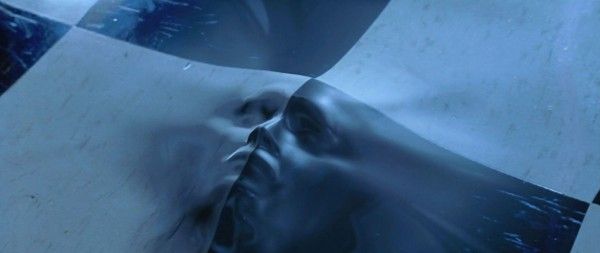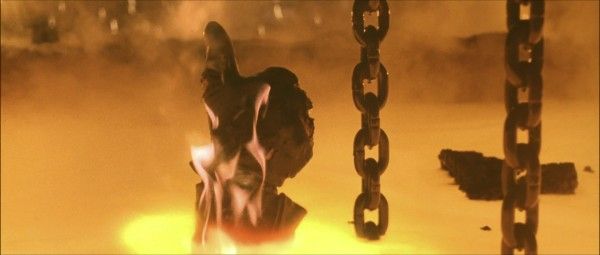Much like John Connor, The Terminator and Terminator 2: Judgment Day (a.k.a “T2”), are both the products of and creators of their time. The Terminator came from a grittier, meaner brand of R-rated, 80s action that melded bloody action with desperate measures. They’re movies that are sweaty, ugly, and gleefully violent mixed with just a bit of campiness. Move to the 90s and everything is much cleaner and glossier. It’s the decade that saw the rise of the PG-13 action film, and the vanishing of the gritty aesthetic.
Even though the movie is rated-R, Terminator 2 helped set the tone for this new wave of action movies. It’s drastically different than the original, features far more visual effects, and at the time was the most expensive movie ever made (James Cameron: Wanting His Movies to Cost More than the GDP of Small Countries since 1991). T2 showed that The Terminator may have been influential in the 1980s, but the sequel was a game-changer that redefined the character, the franchise, and, the blockbuster action movie.
In a world where there was no marketing or word-of-mouth, Terminator 2’s opening is fairly clever since it doesn’t tell you which Terminator is which, and you could assume—at least for a little while—that Arnold Schwarzenegger is playing the evil Terminator again, although that quickly vanishes because this movie is about playing nice. The villain is now the hero, and he’s also the underdog (as much as Schwarzenegger can ever play the underdog) when faced with a more advanced, shinier, cooler Terminator, the T-1000 (Robert Patrick).
Terminator 2: Judgment Day constantly shows itself to be the inverse of The Terminator. In The Terminator, there’s a machine hiding beneath a human exterior. It’s an exterior that physically perfect (or what was considered physical perfection in the 1980s) and emotionally hollow. Terminator 2, on the other hand, is about finding the human inside a machine. The T-800’s programming is intended to learn how to be more human, which is a mechanism to support termination, but young John Connor (Edward Furlong) uses it to create some semblance of humanity inside the killer cyborg.
The Terminator’s mission in the first film is to perform a “retroactive abortion” by killing Sarah Connor (Linda Hamilton) before her son is born. T2 is about creating a surrogate father figure for John Connor, and even Sarah acknowledges in voiceover, “In an insane world, it was the sanest choice.” But it’s her narration before this line that really subverts Reese’s description from the first movie. In The Terminator, Reese says of the Terminator:
It can be bargained with. It can't be reasoned with It doesn't feel pity, or remorse, or fear. And it absolutely will not stop, ever, until you are dead.
But when Sarah sees the T-800 interacting with John in T2, she narrates:
The Terminator, would never stop. It would never leave him, and it would never hurt him, never shout at him, or get drunk and hit him, or say it was too busy to spend time with him. It would always be there. And it would die, to protect him.
Judgment Day may explode with violence and disturbing imagery when it comes to visions of nuclear apocalypse, but at its heart, the movie is a friendly tale about the importance of family. Cameron completely turned the Terminator franchise upside down, and found something much nicer in almost every aspect of his story.
T2 takes everything twisted about the original and untwists it except for Sarah Connor, who has now become Kyle Reese. The Terminator deceives us by making us think that Sarah is going off to teach her son to become a warrior, but the telling moment of the final shot are the storm clouds up ahead. They signal not only the coming apocalypse, but it turns out, they also show the fall of Sarah Connor. The hero of the first movie is now locked up in an insane asylum, goes into fits of rage, and is estranged from her son.
Hamilton’s performance is ferocious, and she’s the sole remnant of the first film’s personality. Sarah is such a force of nature that the movie doesn’t even have consistent voiceover until she gets out of the asylum. From there, this is the woman we were promised, and Hamilton cements the character as one of cinema’s all-time greatest bad-asses. Yes, the Schwarzenegger is fun to watch and he gets the film’s big emotional moment, but Sarah is the one who has to deal with reality and face serious moral choices. The T-800 is basically a kid’s robot buddy; Sarah Connor contemplated killing a guy in front of his family because it might save the human race.
But T2 chooses not to dwell on these dark moments for too long because it’s a hopeful movie. This time, they’re trying to perform the retroactive abortion on Skynet, who, like John Connor, was created by sending something (The Terminator) back in time that in turn created itself (the microchip and arm left behind, which Cyberdyne then collected). But instead of preparing to create a savior in John Connor, T2 posits that we can save the world right here and now rather than merely brace ourselves for inevitable destruction. “There’s no fate but the one we make for ourselves,” says young John Connor, and Sarah carves “NO FATE” into the table when they make their pit stop on the outskirts of the city. Cameron wants to give the audience hope, because when we have hope, we can enjoy ourselves guilt-free.
Which is particularly easy when the action is so good (no one today would ever fly a helicopter under an overpass) and the special effects aren’t only groundbreaking, but also imaginative. The T-1000 effect still holds up in part because of its graceful simplicity. It was a monumental achievement at the time, but it continues to work because it’s used so cleverly like when the T-1000 hides in the hospital’s floor or turns its arms into crowbars. The T-1000 is also a nice juxtaposition to the T-800. One is a graceful, multifaceted killing machine while the other is a bulky, hard-charging blunt instrument. These two personalities blend well in the action scenes, and you can feel the vacuum when the T-1000 drops out for a long stretch of the plot.
The T-1000 is terrific threat, and a good antagonist, but it’s not a Terminator on the level of the first film’s T-800. Robert Patrick gives a great performance, and the T-1000 is unique, but he’s not terrifying. He’s cool to watch whereas The Terminator’s T-800 was disturbing. Terminator 2 never wants to unsettle the audience. This time, the line “I’ll be back,” is meant to comfort and reassure.
And that’s because Terminator 2 is a comforting, reassuring, rah-rah action film that ditches complexity in favor of emotional warmth. It’s a hard road to get a machine played by Arnold Schwarzenegger to convincingly deliver the line, “I know now why you cry, but it is something I can never do.” Then Cameron adds another iconic moment in a movie full of them with the thumbs up coming out of the molten metal. It all culminates into a message of tentative hope. It’s a dark highway ahead, but Sarah Connor tells us "if a machine can learn the value of human life, maybe we can too." It’s a half step away from “Give peace a chance.” But it’s a nice message in a nice movie.
“It has to end here,” The Terminator tells John Connor.
It should have.
Tomorrow: Terminator 3: Rise of the Machines
Other Entries:


